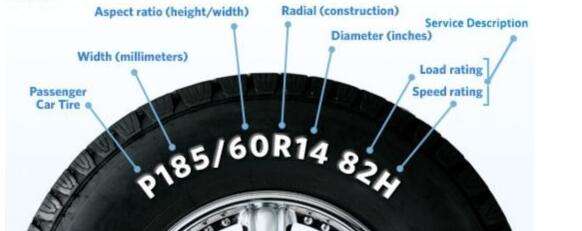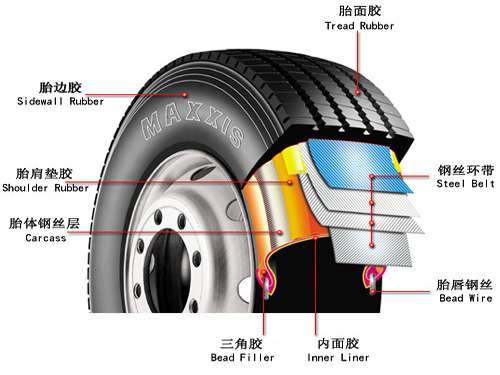
Tire size, is the tire geometry and physical properties of the sign data. Different specifications of the tire performance for the vehicle performance and comfort will have an impact
Example of tire specification
The tire size in the above figure is 195 / 65R15 91V, where 195 is the width of the tire 195mm; 65 is the tire height and width of the percentage of 65%, that is, flat tire ratio; "R" represents the word RADIAL, said yes Radial tire; 15 that the rim diameter of 15 inches; 91 said the load index; V is the tire's permissible speed grade

Tire specifications mean
International standard tire specifications, generally composed of six parts, "tire width (mm) + tire section flat ratio (%) + tire type code + rim diameter (inch) + load index + allowable vehicle speed code."
Tire width, rim diameter and flatness As shown above, the flattening ratio is the percentage of the tire thickness to the tire width.
Tire width, is the impact of vehicle fuel consumption performance of a factor.
The wider the tire, the greater the area of contact with the ground, the corresponding increase in the friction between the tire and the ground, the kinetic energy of the car into friction heat energy and the loss of energy will increase, should the same distance when driving the same tire more easily consume oil. But things have its two sides, although the increase in fuel consumption, but the grip of the wider tire to be stronger, and then also will get better body stability.
Flat ratio
Flat ratio, the impact of the vehicle is the main factor of the reaction sensitivity of the road. The lower the flattening of the vehicle, the thinner the tire wall, and the greater the pressure on the tire, the response to the road is very sensitive to the road quickly to the signal transmission to the driver, more user-friendly, more common in some performance Control known for long models. The higher the flatness ratio, the thicker the tire wall, although there is sufficient buffer thickness, but the feeling of poor road, especially when the turn is relatively more bureaucratic, more common in some of the models known for comfort. There is a flat off-road vehicles than the average higher, mainly in order to adapt to the harsh road conditions.
Tire type code
Tire type code, common that have "X" high-pressure tires, "R", "Z" radial tires, "a" low-pressure tires. The car on the market generally use radial tires, and now has achieved a radial tire without tubules, commonly known as "atomic child." This tire is not easy in the high-speed heating, when the tires are punched by nails or sharp objects, the leak slowly, can continue to drive a distance. In addition, atomic tires also simplify the production process, reduce weight, save raw materials and other benefits.
Load index
Load index is a tire can bear the maximum load in the form of code to represent the capacity of the tire to bear the load, the greater the value, the tire can bear the greater load. The load index and corresponding bearing quality are listed below.
Allowable speed indicates the limit of the speed of the vehicle, more than may lead to puncture, the higher the speed level, the tire design and the higher the requirements of the material.
Such as:
The specification of one tire is 205/55 / R16 91V
205 - refers to the tire width of 205 mm.
55 - refers to the tire flat ratio, the section height is 55% of the width.
R - refers to the tire for the radial tire (the tire inner tire manufacturing methods for the radiation)
16 - refers to the rim diameter is 16 inches.
91 - refers to the load index of 91, on behalf of this tire maximum load-bearing 615 kg, four tires is 615 × 4 = 2460 kg.
V-refers to the speed level of 240 km / h.
Attached:
1. Tire Load Index: 82-475, 83-487, 84-500, 85-515, 86-530, 87-545, 88-560, 89-580, 90-600, 91-615, 92-630, 93-650, 94-670 too much, not one by one list, the largest 108-1000
2. Tire safety speed mark table ___ (code VS. safe speed limit)
F 80 km / h G 90 km / h J 100 km / h
K 110 km / h L 120 km / h M 130 km / h
N 140 km / h P 150 km / h Q 160 km / h
R 170 km / h S 180 km / h T 190 km / h
U 200 km / h H 210 km / h V 240 km / h
ZR 240 km / h or more
Tire specification level
Level refers to the tire rubber layer within the nominal number of layers, with the actual number of layers is not exactly the same, is an important indicator of tire strength. Level marked with Chinese, such as 12 levels; marked in English, such as "14P.R" that is 14 levels.
Rim specification
Indicates the rim size for use with the tire. Easy to use, such as "Standard Rim 5.00F". Speed rating
The tire carries the specified maximum load of the load under specified conditions. The letters A to Z represent the speed rating of the tire from 4.8 km / h to 300 km / h. Common speed grade:
H: 210 km / h; V: 240 km / h; W: 270 km / h; Y: 300 km / h; Z: ZR speed higher than 240km / h.
Tire practical application
Some people will tire analogy to wear shoes, which is not a bad idea, but have not heard of the rupture will be out of the soles of the story, while the tire burst caused by car crash news is heard. From this perspective, the importance of the tire on the vehicle far more than the importance of shoes. Therefore, the correct use of tires not only affect the operating status of the car, the car's safety is more important impact.
Know the tire to read the logo
Proper use of tires First of all to know the tires, tire first know how to understand the logo on the tire.
For example, Guangzhou Accord 2.3i tire logo is 195 / 65R15 (91V), which means the tread width 195 mm, aspect ratio 65R15 refers to the radial tire, tire diameter 15 inches, load capacity of 91 that the maximum carrying capacity of 615 kg, the speed of the code V, indicating that the safety speed is 240 km.

Some tires also marked M + S, said the mud, snow, TUBELESS said no tubing, TreadWear said tread wear index.
One of the important parameters for a passenger car tire is the aspect ratio, which is the flatness ratio, which is derived from the formula (H / W) where H is the tire cross-sectional height and W is the maximum tire- width.
The smaller the value of the formula is, the tighter the cross-section of the tire is (see "Technical Talk" -> Chassis -> Tires -> Tires for Modern Cars).
Some owners in order to make the car has good driving stability, like to use low aspect ratio tires, for different aspect ratio of tire exchange, preferably with the same diameter as the basis, if the tire diameter and rim diameter is not Change, low aspect ratio tread will appear wider, the contact surface will be greater, so that the car driving and steering more stable. If the tire diameter is not the same, must be replaced with the rim, then the scope of the larger, such as the wheel drum matching problems, suspension geometry, turning radius and so may be associated, must be careful.